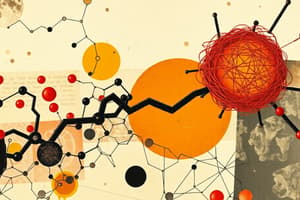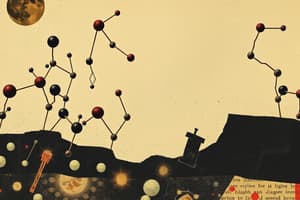Podcast
Questions and Answers
What is the primary function of high density lipoproteins (HDLs) in the body?
What is the primary function of high density lipoproteins (HDLs) in the body?
- To transport cholesterol to tissues for cell membrane synthesis
- To deposit cholesterol in the arteries
- To provide energy by transporting triacylglycerols to muscles
- To remove excess cholesterol from tissues and transport it to the liver (correct)
Which of the following statements about steroids, particularly adrenal corticosteroids, is correct?
Which of the following statements about steroids, particularly adrenal corticosteroids, is correct?
- They are a type of lipoprotein.
- They can reduce inflammation and treat conditions like asthma. (correct)
- They are derived from cholesterol.
- They are primarily used for energy production.
What role do chylomicrons and very low density lipoproteins (VLDLs) play in lipid transport?
What role do chylomicrons and very low density lipoproteins (VLDLs) play in lipid transport?
- They are involved in producing arachidonic acid.
- They are responsible for removing cholesterol from tissues.
- They help synthesize bile salts in the liver.
- They transport triacylglycerols and cholesterol to tissues for storage or energy. (correct)
Prostaglandins have various physiological effects. Which of the following functions do they perform?
Prostaglandins have various physiological effects. Which of the following functions do they perform?
Which statement accurately describes lipoproteins?
Which statement accurately describes lipoproteins?
What is the primary role of cholesterol in the cell membrane?
What is the primary role of cholesterol in the cell membrane?
What are the main components of a cell membrane?
What are the main components of a cell membrane?
Which type of proteins extend through the entire lipid bilayer of the cell membrane?
Which type of proteins extend through the entire lipid bilayer of the cell membrane?
In which application is lanolin most commonly used?
In which application is lanolin most commonly used?
How do glycerophospholipids contribute to the structure of the cell membrane?
How do glycerophospholipids contribute to the structure of the cell membrane?
What type of fatty acids do glycerophospholipids primarily contain?
What type of fatty acids do glycerophospholipids primarily contain?
Which wax is specifically known for its use as a protective coating on furniture and cars?
Which wax is specifically known for its use as a protective coating on furniture and cars?
Which of the following correctly describes the relationship between the components of the cell membrane?
Which of the following correctly describes the relationship between the components of the cell membrane?
What is the primary role of lipoproteins in the body?
What is the primary role of lipoproteins in the body?
Which of the following statements about steroid hormones is true?
Which of the following statements about steroid hormones is true?
What effect do prostaglandins have in the body?
What effect do prostaglandins have in the body?
What are waxes primarily used for in biological systems?
What are waxes primarily used for in biological systems?
What is a key component of cell membranes formed by lipids?
What is a key component of cell membranes formed by lipids?
How do saturated and unsaturated fatty acids differ at room temperature?
How do saturated and unsaturated fatty acids differ at room temperature?
What is one of the major functions of bile salts?
What is one of the major functions of bile salts?
Which amino alcohols are typically found in glycerophospholipids?
Which amino alcohols are typically found in glycerophospholipids?
What is a characteristic of unsaturated fatty acids?
What is a characteristic of unsaturated fatty acids?
Which of the following is true about triacylglycerols?
Which of the following is true about triacylglycerols?
In what type of food sources are saturated fats predominantly found?
In what type of food sources are saturated fats predominantly found?
What role do steroid hormones primarily serve in the body?
What role do steroid hormones primarily serve in the body?
What happens during hydrogenation of unsaturated fats?
What happens during hydrogenation of unsaturated fats?
Flashcards
Prostaglandins
Prostaglandins
Chemicals that cause inflammation and pain.
Waxes
Waxes
Esters of fatty acids and alcohols, used for waterproofing and protection.
Cell Membrane
Cell Membrane
The boundary of a cell, separating the inside from the outside.
Lipid Bilayer
Lipid Bilayer
Signup and view all the flashcards
Glycerophospholipids
Glycerophospholipids
Signup and view all the flashcards
Fluid Mosaic Model
Fluid Mosaic Model
Signup and view all the flashcards
Peripheral Proteins
Peripheral Proteins
Signup and view all the flashcards
Integral Proteins
Integral Proteins
Signup and view all the flashcards
Adrenal Corticosteroids
Adrenal Corticosteroids
Signup and view all the flashcards
Lipoproteins
Lipoproteins
Signup and view all the flashcards
LDL (Low-density lipoprotein)
LDL (Low-density lipoprotein)
Signup and view all the flashcards
HDL (High-density lipoprotein)
HDL (High-density lipoprotein)
Signup and view all the flashcards
Prostaglandins
Prostaglandins
Signup and view all the flashcards
Lipids
Lipids
Signup and view all the flashcards
Fatty Acids
Fatty Acids
Signup and view all the flashcards
Saturated Fatty Acids
Saturated Fatty Acids
Signup and view all the flashcards
Unsaturated Fatty Acids
Unsaturated Fatty Acids
Signup and view all the flashcards
Triacylglycerols
Triacylglycerols
Signup and view all the flashcards
Fat
Fat
Signup and view all the flashcards
Oil
Oil
Signup and view all the flashcards
Hydrogenation
Hydrogenation
Signup and view all the flashcards
Hydrolysis
Hydrolysis
Signup and view all the flashcards
Saponification
Saponification
Signup and view all the flashcards
Glycerophospholipids
Glycerophospholipids
Signup and view all the flashcards
Steroids
Steroids
Signup and view all the flashcards
Cholesterol
Cholesterol
Signup and view all the flashcards
Bile Salts
Bile Salts
Signup and view all the flashcards
Steroid Hormones
Steroid Hormones
Signup and view all the flashcards
Study Notes
Lipids
- Lipids are biomolecules containing fatty acids or a steroid nucleus.
- They are soluble in organic solvents but not in water.
- The Greek word "lipos" means "fat".
- Lipids are extracted from cells using organic solvents.
- They are grouped according to their chemical composition, and are derivatives of fatty acids.
Fatty Acids
- Fatty acids are hydrocarbon derivatives with 4 to 36 carbons.
- They have ester or amide linkages.
- Fatty acids (FFAs) are monocarboxylic acids, have an even number of carbon atoms, are saturated or unsaturated, and can be branched or substituted.
- Examples of saturated fatty acids include lauric acid (12 carbons), myristic acid (14 carbons), palmitic acid (16 carbons), and stearic acid (18 carbons).
- Sources and melting points for these saturated fatty acids are shown in the provided table.
- Monounsaturated fatty acids include palmitoleic acid (16 carbons) and oleic acid (18 carbons).
- Polyunsaturated fatty acids include linoleic acid (18 carbons), linolenic acid (18 carbons), and arachidonic acid (20 carbons).
Fatty Acids - Physical Properties
- Saturated fatty acids have a regular pattern of close packing, resulting in a solid state at room temperature.
- Unsaturated fatty acids contain cis double bonds, causing a bend or kink in the carbon chain, making them liquid oils at room temperature.
Fats and Oils - Triacylglycerols
- Triacylglycerols (fats and oils) store fatty acids in the body.
- Fats are solid at room temperature.
- Oils are liquid at room temperature and come from plants.
- Triacylglycerols are triesters of glycerol and fatty acids.
- Glycerol is a trihydroxy alcohol.
- Esters bonds link glycerol with fatty acids.
- Chemical reactions involve similar reactions to alkenes.
- Hydrogenation adds hydrogen to unsaturated fats, forming saturated fats.
- Hydrolysis breaks the ester bonds in the presence of strong acids or digestive enzymes called lipases.
Fats and Oils - Triacylglycerols Reactions
- Saponification involves heating fat with strong bases (like sodium hydroxide) to form glycerol and soap (sodium salts of fatty acids).
Glycerophospholipids
- Glycerophospholipids are similar to triacylglycerols but replace one glycerol hydroxyl group with a phosphoric acid ester and an amino alcohol (bonded through a phosphodiester bond).
- Amino alcohols in glycerophospholipids include choline, serine, and ethanolamine.
- Lecithins and cephalins are abundant in brain and nerve tissues, egg yolks, and wheat germ
- Glycerophospholipids contain both polar and nonpolar regions. They're essential for cell membranes.
Steroids: Cholesterol, Bile Salts, and Hormones
- Steroids have a steroid nucleus consisting of three cyclohexane rings and one cyclopentane ring.
- Cholesterol is an abundant steroid.
- It's crucial for cellular membranes, myelin sheath, and nerve tissue formation.
- Cholesterol is found in the liver, bile salts, and skin, where it's involved in Vitamin D formation..
- Cholesterol is used to synthesize steroid hormones. Steroid hormones and other hormones in adrenal glands also depend on cholesterol.
Steroids: Bile Salts
- Bile salts aid digestion of fats and oils by emulsifying them.
- Bile salts mix with water-insoluble fats and oils in the small intestine. They break down fat into smaller globules, enlarging the surface area that lipases act on.
- They're synthesized in the liver using cholesterol and stored in the gallbladder.
Steroids: Steroid Hormones
- Hormones are chemical messengers that regulate body processes.
- Steroid hormones are closely related to cholesterol in structure and depend on cholesterol for synthesis.
- Types include sex hormones (testosterone, androsterone) and adrenocortical hormones (like cortisone, aldosterone).
Steroids: Adrenal Corticosteroids
- Adrenal glands on top of kidneys produce corticosteroids.
- Corticosteroids come in two types:
- Mineralocorticoids: (like aldosterone) regulate electrolyte and water balance.
- Glucocorticoids (like cortisone) impact blood glucose and glycogen synthesis.
- Synthetic corticoids (like prednisone) are used to reduce inflammation.
Lipoproteins
- Lipoproteins transport lipids through the bloodstream to tissues.
- Lipids are nonpolar and need to be made more soluble for transport.
- Lipoproteins form water-soluble complexes by combining lipids with proteins and phospholipids.
- Lipoproteins are spherical particles with a polar exterior composed of proteins and phospholipids. They have a nonpolar core of triacylglycerols and cholesteryl esters.
- Chylomicrons, VLDLs, LDLs, and HDLs have different densities, compositions, and roles.
- LDLs (low-density lipoproteins) carry cholesterol to tissues, excess LDL cholesterol is a concern.
- HDLs (high-density lipoproteins) carry cholesterol from tissues to the liver for removal. HDLs are important because they remove excess cholesterol from body tissues.
Prostaglandins
- Prostaglandins are hormone-like substances produced in small amounts in most cells and also known as eicosanoids.
- They are derived from arachidonic acid, a polyunsaturated fatty acid.
- Prostaglandins have many potent physiological effects, like regulating blood pressure and influencing smooth muscle contractions (e.g. uterine muscles).
- They impact inflammation and generate pain sensations.
Waxes
- Waxes are esters of a saturated fatty acid and a long-chain alcohol.
- They provide a protective coating for plants (e.g. on fruits, leaves, stems) and animals (e.g., fur, skin, feathers).
- Examples include beeswax, carnauba wax, jojoba wax, and lanolin.
Cell Membrane
- Cell membranes separate the cell's interior from the external environment.
- They're semipermeable, allowing nutrients to enter and waste products to leave.
- The main component is a lipid bilayer (two layers of glycerophospholipids).
- Hydrophobic tails face inwards, and hydrophilic heads face outwards (in contact with the surrounding environment inside and outside the cell).
- Cell membranes also include proteins (peripheral and integral) carbohydrates, and cholesterol which helps regulate flexibility and also provide stability.
- Transport processes occur through the membrane
Studying That Suits You
Use AI to generate personalized quizzes and flashcards to suit your learning preferences.




